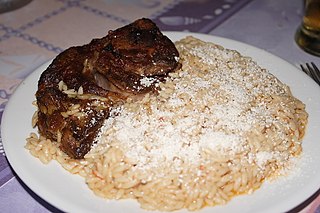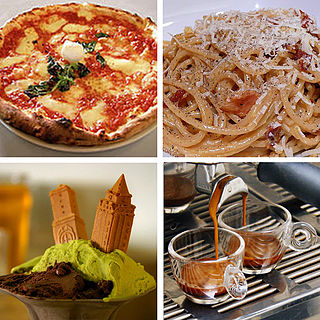
Greek cuisine is the cuisine of Greece and the Greek diaspora. In common with many other cuisines of the Mediterranean, it is founded on the triad of wheat, olive oil, and wine. It uses vegetables, olive oil, grains, fish, and meat, including pork, poultry, veal and beef, lamb, rabbit, and goat. Other important ingredients include pasta, cheeses, lemon juice, herbs, olives and olive oil, and yogurt. Bread made of wheat is ubiquitous; other grains, notably barley, are also used, especially for paximathia. Common dessert ingredients include nuts, honey, fruits, sesame, and filo pastries. It continues traditions from Ancient Greek and Byzantine cuisine, while incorporating Turkish, Balkan, and Italian influences.

Moroccan cuisine is the cuisine of Morocco, fueled by interactions and exchanges with many cultures and nations over the centuries. Moroccan cuisine is usually a mix of Arab, Berber, Andalusi, and Mediterranean cuisines, with minimal European and sub-Saharan influences. Like the rest of the Maghrebi cuisine, Moroccan cuisine has more in common with Middle Eastern cuisine than with the rest of Africa.

Spanish cuisine consists of the traditions and practices of Spanish cooking. It features considerable regional diversity, with important differences between the traditions of each of Spain's regional cuisines.

Catalan cuisine is the cuisine from Catalonia. It may also refer to the shared cuisine of Northern Catalonia and Andorra, the second of which has a similar cuisine to that of the neighbouring Alt Urgell and Cerdanya comarques and which is often referred to as "Catalan mountain cuisine". It is considered a part of western Mediterranean cuisine.

English cuisine encompasses the cooking styles, traditions and recipes associated with England. It has distinctive attributes of its own, but is also very similar to wider British cuisine, partly historically and partly due to the import of ingredients and ideas from the Americas, China, and India during the time of the British Empire and as a result of post-war immigration.

Lasagna, also known as lasagne, is a type of pasta, possibly one of the oldest types, made in very wide, flat sheets. The same-named Italian dish is made of stacked layers of lasagna alternating with fillings such as ragù, béchamel sauce, vegetables, cheeses, and seasonings and spices. The dish may be topped with grated cheese, which becomes melted during baking. Typically cooked pasta is assembled with the other ingredients and then baked in an oven. The resulting baked pasta is cut into single-serving square or rectangular portions.

A cookbook or cookery book is a kitchen reference containing recipes.

A mirepoix is a mixture of diced vegetables cooked with fat for a long time on low heat without coloring or browning. The ingredients are not sautéed or otherwise hard-cooked, because the intention is to sweeten rather than caramelize them. Mirepoix is a long-standing part of French cuisine and is the flavor base for a wide variety of dishes, including stocks, soups, stews, and sauces.

Gastronomy is the study of the relationship between food and culture, the art of preparing and serving rich or delicate and appetizing food, the cooking styles of particular regions, and the science of good eating. One who is well versed in gastronomy is called a gastronome, while a gastronomist is one who unites theory and practice in the study of gastronomy. Practical gastronomy is associated with the practice and study of the preparation, production, and service of the various foods and beverages, from countries around the world. Theoretical gastronomy supports practical gastronomy. It is related with a system and process approach, focused on recipes, techniques and cookery books. Food gastronomy is connected with food and beverages and their genesis. Technical gastronomy underpins practical gastronomy, introducing a rigorous approach to evaluation of gastronomic topics.

Elizabeth David was a British cookery writer. In the mid-20th century she strongly influenced the revitalisation of home cookery in her native country and beyond with articles and books about European cuisines and traditional British dishes.

Mediterranean cuisine is the food and methods of preparation used by the people of the Mediterranean Basin. The idea of a Mediterranean cuisine originates with the cookery writer Elizabeth David's book, A Book of Mediterranean Food (1950) and was amplified by other writers working in English.

Sofrito, sofregit, soffritto, or refogado, is a basic preparation in Mediterranean, Latin American, Spanish, Italian and Portuguese cooking. It typically consists of aromatic ingredients cut into small pieces and sautéed or braised in cooking oil for a long period of time over a low heat.

Italian cuisine is a Mediterranean cuisine consisting of the ingredients, recipes and cooking techniques developed in Italy since Roman times and later spread around the world together with waves of Italian diaspora. Some of these foods were imported from other cultures. Significant changes occurred with the colonization of the Americas and the introduction of potatoes, tomatoes, capsicums, maize and sugar beet—the latter introduced in quantity in the 18th century. It is one of the best-known and most appreciated gastronomies worldwide.
Futurist meals comprised a cuisine and style of dining advocated by some members of the Futurist movement, particularly in Italy. These meals were first proposed in Filippo Tommaso Marinetti and Luigi Colombo (Fillìa)'s Manifesto of Futurist Cooking, published in Turin's Gazzetta del Popolo on December 28, 1930. In 1932, Marinetti and Fillìa expanded upon these concepts in The Futurist Cookbook.
Elizabeth David, the British cookery writer, published eight books in the 34 years between 1950 and 1984; the last was issued eight years before her death. After David's death, her literary executor, Jill Norman, supervised the publication of eight more books, drawing on David's unpublished manuscripts and research and on her published writings for books and magazines.

The history of Argentine cuisine is rich and diverse. As a land that has experienced extensive immigration through many years, the country has benefited from numerous food influences. The diverse climate in the region, ranging from subtropical to subpolar, has also helped to considerably broaden the set of ingredients readily available. European settlers are largely responsible for Argentina's cuisine, mostly the Italians and Spaniards. However, other immigrants such as Germans, the French, Jews and the British, among others, brought their styles of cooking and national recipes with them. Nevertheless, indigenous gastronomies derived from groups such as the Quechua, Mapuche, and Guarani have also played a role; for example, mate is consumed throughout the country.

Lyonnaise cuisine refers to cooking traditions and practices centering on the area around the French city of Lyon and historical Lyonnais culinary traditions.

Monégasque cuisine is the cuisine of the principality of Monaco. It is a Mediterranean cuisine shaped by the cooking style of Provence and the influences of nearby northern Italian and southern French cooking, in addition to Monaco’s own culinary traditions. There is an emphasis on fresh ingredients, with the use of seafood, vegetables and olive oil playing a major role in the cuisine.
Diane Kochilas is a Greek American cookbook author, celebrity chef, and cooking school owner. She has appeared on numerous American television programs, including Throwdown! with Bobby Flay, Bizarre Foods with Andrew Zimmern, The Today Show, PBS News Hour, and Martha Stewart. In Greece and Cyprus, Kochilas hosted the TV cooking show Τι Θα Φάμε Σήμερα Μαμά; on Alpha Channel and Sigma in Cyprus. She runs the Glorious Greek Kitchen Cooking School on the Blue-Zone Greek Island of Ikaria.
















